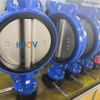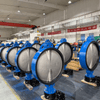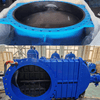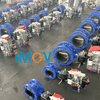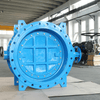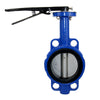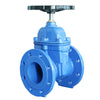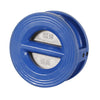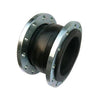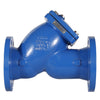Complete Guide to Butterfly Valve Stem Design, Function, and Materials
The butterfly valve stem is the core component of the butterfly valve, serving as the valve's backbone. When the disc regulates flow and the seat achieves sealing, it is the stem that governs the entire opening and closing operation. A thorough understanding of its function, design, and material selection is crucial for ensuring the reliability and service life of valves within any piping system.
This article systematically outlines the core functions, key design characteristics, material options, and common operational issues pertaining to butterfly valve stems.
Core Functions of the Butterfly Valve Stem
The butterfly valve stem serves as a mechanical shaft performing several critical roles:
- Torque Transmission: The primary function of the stem is to transmit rotational torque from the actuator (manual, electric, or pneumatic) to the disc. Without the stem, the disc cannot rotate to open or close the valve.
- Support and Positioning: The stem passes through the disc, serving as its rotational axis. It provides essential support, ensuring stable and precise disc rotation without wobble or misalignment – critical for achieving a tight seal.
- Opening and Closing Action: By rotating 90 degrees, the butterfly valve stem drives the disc from the closed position (perpendicular to the flow direction) to the open position (parallel to the flow direction), thereby controlling flow.
- Load Bearing: The stem must withstand not only the pressure of the medium and the weight of the disc, but also resist the operating forces and vibration impacts from the actuator.
Consequently, it must possess sufficient mechanical strength and rigidity.

Key Design Features of Butterfly Valve Stems
1.Connection to the Disc
The method of connecting the stem to the disc is a key design consideration, ensuring effective torque transmission and preventing disc loosening.
- Square or Flat-Face Connection: The most common method. The stem is machined with a square or flat cross-section that mates tightly with a corresponding bore in the disc. This approach is simple, economical, and highly reliable.
- Keyed Connection: Utilises keys (e.g., flat or crescent keys) to secure the stem to the disc. This is typically employed in large valves or high-pressure differential applications requiring transmission of greater torque.
-
Integral / One-Piece Design:The valve stem and disc are forged or cast as a single unit, forming a rigid connection that eliminates the risk of loosening or wear at joints. This design is suitable for high-pressure, high-frequency operation, or demanding service conditions. Depending on the structure, it can be further categorised into the following types:
- Full Shaft Design: The valve stem passes through the disc and is supported at both ends, offering the highest overall strength. Suitable for large-diameter, high-pressure, or critical fluid control systems.
- Split Shaft Design: The disc is connected to upper and lower short shaft segments, secured via pins or similar fasteners. This design maintains strength while reducing weight, facilitating installation and maintenance. Commonly used in medium to large-diameter valves.

2. Axial Fixation of the Valve Stem
Primarily employed to ensure positional stability of the valve stem during operation, preventing bidirectional movement.
- Threaded Lock Nut Fixing: Utilising a nut at the stem end provides reliable fixation capable of withstanding high loads, representing one of the most common and effective methods.
- Retaining Ring/Spring Collar Fixing: Offering a compact structure and ease of installation/removal, this method is primarily used for axial positioning in medium-to-low pressure applications.
- Important Note: Glands used for stem sealing serve solely to compress packing. They must never be employed as axial fixing structures.
3. Stem Sealing Systems
The stem penetration through the valve body constitutes a potential leakage point. A dependable sealing system is essential:
Common solutions include:
- O-rings: Suitable for low-pressure and low-temperature applications.
- Packing seals: A traditional and adjustable method employing rings of compressible materials such as graphite or PTFE, compressed by a gland to form a seal around the stem.
- Lip seals: Provide excellent dynamic sealing performance and are often combined with other seals to prevent contamination.
4. Blowout-Proof Design
High-pressure butterfly valves typically incorporate a blowout prevention step structure, ensuring the valve stem cannot be forced out of the body under internal pressure, thereby meeting the safety requirements of API 609.
5. Actuator Interface Standard:
The valve stem end conforms to EN ISO 5211. This enables direct actuator mounting with interchangeability. The most common interface is the square-end design, facilitating straightforward installation without special adapters.
Common Materials for Butterfly Valve Stems
Selecting the right valve stem material requires balancing corrosion resistance, temperature and pressure tolerance, and overall cost-effectiveness.
|
Material |
Key Characteristics |
Typical Applications |
|
304 / 304L Stainless Steel |
A general-purpose material with good overall corrosion resistance and mechanical strength. |
Suitable for water, air, steam, and other non-corrosive media. |
|
316 / 316L Stainless Steel |
Contains molybdenum, offering enhanced corrosion resistance—especially against chlorides. |
Commonly used in chemical processing, seawater systems, and the food & beverage industry. |
|
17-4PH (Type 630 Stainless Steel) |
A precipitation-hardened stainless steel providing extremely high strength (3–4× stronger than 304) and excellent corrosion resistance. |
Ideal for high-cycle, high-torque, or high-pressure applications. |
|
Duplex Stainless Steel (2205) |
Combines high mechanical strength with outstanding resistance to chloride stress corrosion cracking. |
Used in offshore, marine, and demanding chemical environments. |
|
Carbon Steel (Plated) |
Cost-effective but requires protective surface plating (e.g., nickel or chrome) to prevent corrosion. |
Suitable for general industrial pipelines and non-corrosive environments. |

Common Butterfly Valve Stem Problems and Solutions
|
Problem |
Main Cause |
Recommended Solution |
|
Stem Seized / Excessive Operating Torque |
Medium crystallization or solid particles entering the bushing; insufficient lubrication; corrosion leading to galling |
Use PTFE composite bushings; select corrosion-resistant materials; keep the medium clean |
|
External Leakage at Stem |
Worn or aged sealing elements; loose gland; scratches on stem surface |
Replace seals regularly; adjust the gland tightness; maintain a smooth stem surface finish |
|
Stem Breakage |
Excessive operating torque; insufficient material strength; forcing operation when the disc is jammed |
Use high-strength materials such as 17-4PH; avoid over-torquing; install strainers or filters to prevent blockage |
|
Loosening at Disc–Stem Connection |
Improper connection design or poor machining accuracy; vibration fatigue |
Use square-head or one-piece designs; ensure high machining precision and proper alignment |
The butterfly valve stem is far more than a simple metal rod; it serves as the critical link between control and function. The integrity of its design, the strength of its materials, and its resistance to corrosion are paramount to the valve's performance and service life. By paying close attention to butterfly valve stem specifications during selection and maintenance, engineers can ensure the long-term, reliable operation of their fluid handling systems.
At Union Valve, we consistently prioritise foundational components, approaching every detail with engineering rigour. Through stringent material selection, precision machining, and comprehensive testing throughout the production process, we guarantee each butterfly valve operates reliably under complex conditions, delivering secure and dependable fluid control solutions to our customers.
Should you have any further queries, please do not hesitate to contact us.
